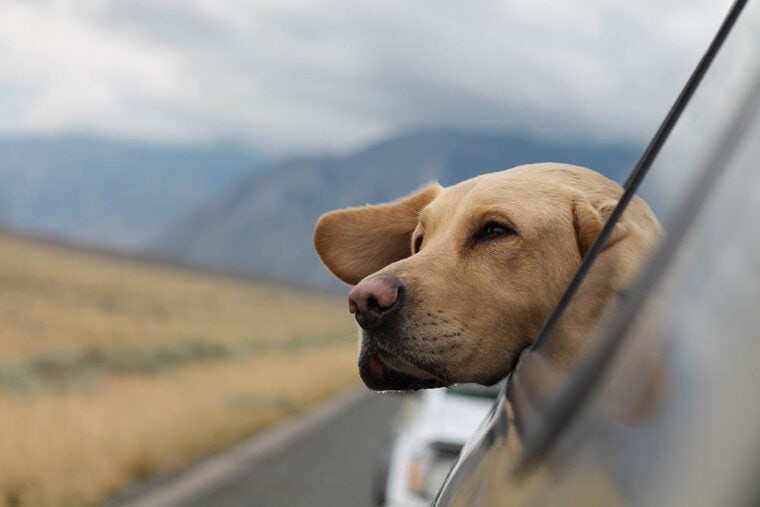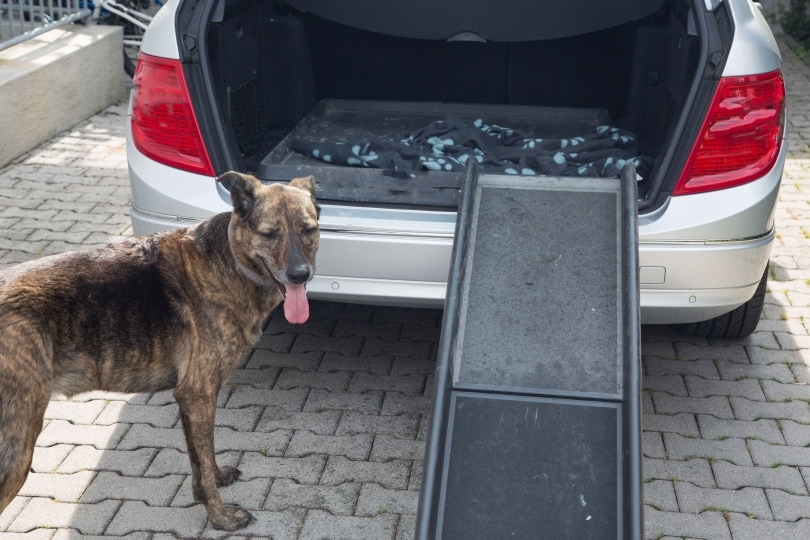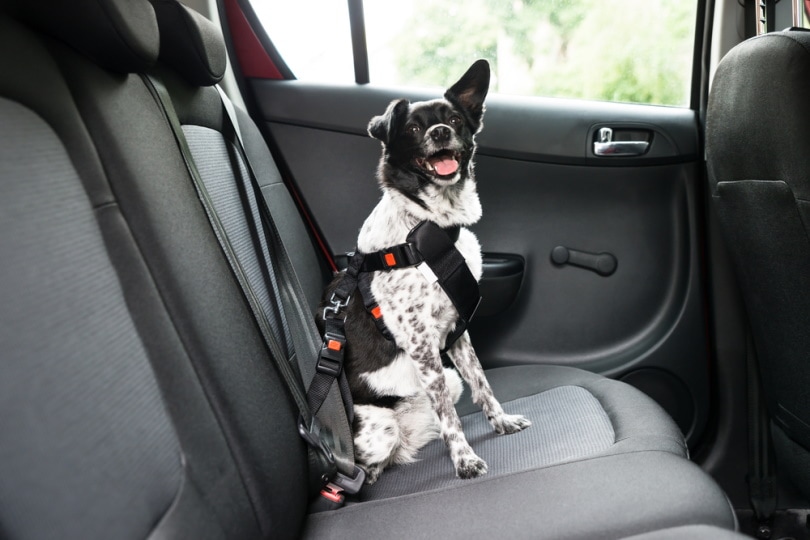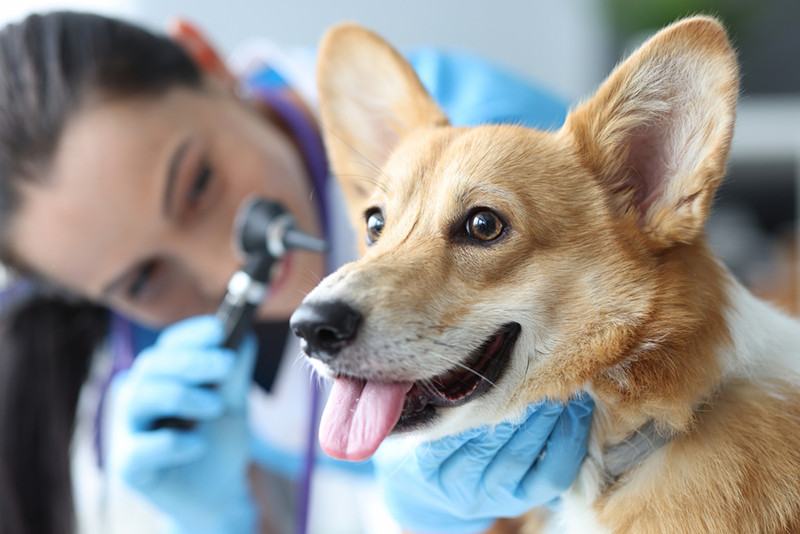
Click to Skip Ahead
Some dogs can’t get enough of car rides, while for others, it’s a dizzy nightmare waiting to happen. It’s a bad time for their humans, too. Dealing with a car-sick pet while cleaning up everything from drool to pee and vomit is never fun.
Still, your dog will need to ride in a car at some point, whether to the vet or your parent’s house for the holidays.
The good news is that there are many ways to make car rides more comfortable—and even pleasant—for your pup.
Signs of Car Sickness in Dogs
The severity of signs of car sickness in dogs can vary, ranging from mild signs to severe reactions. For instance, some pups may just yawn or look a bit drowsy in the car, while others may start to drool and vomit.
Some dogs may even refuse to enter the car or become aggressive out of fear or anxiety.
 The 8 Ways to Help a Dog With Car Sickness
The 8 Ways to Help a Dog With Car Sickness
It’s important to know that car sickness can affect even the healthiest dog, so try not to panic or feel guilty if your pup experiences it.
Helping a car-sick dog can involve a combo of behavior modification, natural remedies, and medical interventions.
Here are some simple yet effective ways to make car rides more enjoyable for your pup:
1. Get Your Dog Used to Being in the Car
If the mere sight of a vehicle triggers your dog’s anxiety, it’s time to help them get used to it. Start slow—and we mean slow. For instance, reward them every time they look in the direction of your car. Then, progress to spending time near it while you play or just hang out. Once your pup is comfortable, move to the next step: getting them in and out of the car while it’s not running.
Turn it into a game! For example, place treats around the car and inside it. Tell them to “look for treats”, and offer big rewards every time they enter or stay inside the car.
Level it up gradually by starting the engine and giving them treats to counter-condition them to the noise. After each session, reward your pup for disregarding the sound of the engine and continuing their activities as normal.
Move onto short trips to places your dog loves (like the park), eventually increasing the time and distance of each ride until they build a tolerance for car trips.
2. Create a Dog-Friendly Area Inside Your Vehicle
Ideally, your dog should have a dedicated space in the car, preferably in the back seat. It should be comfortable with padding or a blanket and plenty of room to move around without feeling cramped.
You can also buy car accessories designed specifically for dogs. For instance, pet seat belts and car hammocks keep them safe and secure during a ride.

3. Block Your Dog’s View of the Outside World
Since car sickness is often caused by the pup’s reaction to visual stimuli, blocking their view of what’s going on outside the car can help keep them calm.
Obscure their vision by using block-out sunscreens or window curtains on their side of the vehicle. Or, cover their crate with a towel or blanket to shield them from what’s happening outside.
4. Take Short Breaks During the Drive
If you have to drive long stretches non-stop, take frequent breaks lasting around 10 minutes along the way. For example, stop at a gas station, park, and let your dog go potty and stretch their legs.
This practice will help them acclimatize to the car environment, allowing them to rest and reset before continuing the journey.

5. Keep the Temperature Cool Inside the Car
A hot car is not only uncomfortable for humans, but it can also make dogs even more anxious and nauseous. Make sure the air conditioning is on and temperature levels are moderate while your pup rides in the car.
You can also try cracking your windows slightly for some fresh air. As a bonus, all those new and interesting smells whizzing by will hopefully distract your dog from their car sickness!
6. Avoid Feeding Them Before a Drive
Limit your pup’s food intake a few hours before the trip. Traveling on a full stomach can make their nausea worse, and lead to vomiting and/or diarrhea.

7. Administer Natural Remedies for Anxiety in Dogs
You can also try a few natural remedies to help your car sick dog. For instance, apply some chamomile or lavender oil to a cotton ball, then leave it inside your car for 30 minutes before you’re set to go. These oils have calming properties that can help your pup stay relaxed during car trips.
You can also fit them with a calming collar or lightly spray some Dog Appeasing Pheromone (DAP) inside your car prior to traveling.
Have your dog wear a calming compression shirt or wrap. These garments are designed to simulate a hugging sensation and can be very reassuring to anxious dogs.
8. Talk to Your Vet About Medical Interventions
If training and natural remedies don’t work, consult your vet. They can check and treat your dog for issues like vestibular disease that may be causing their car sickness.
If needed, your vet can also prescribe medication to help reduce anxiety, nausea, and other symptoms associated with car sickness in dogs.

Why Do Dogs Get Car Sick? 5 Common Reasons
Why do dogs get car sick in the first place? It’s mainly due to motion sickness, which happens when your dog’s equilibrioception is disturbed.
Equilibrioception refers to your pup’s sense of balance, which is a combination of visual cues and inner ear movements. These elements are in sync for dogs who don’t get car sick. For instance, when your dog looks out the window and sees trees whizzing past, the motions of his inner ear match up with the visual scene.
This balance is off for dogs who get car sick. The movement they sense in their inner ears is faster or slower than what they see outside the car, making them feel disoriented and sick.
There are several potential reasons why this happens:
1. Underdeveloped vestibular system
Motion or car sickness is more prevalent in puppies and younger dogs, simply because the structures in their inner ears (the vestibular system) aren’t fully developed yet. Once it does, they usually outgrow motion sickness—though not always.

For other dogs, the reason is more psychological than physical. If your pup had a traumatic experience in the car, such as a road accident or ride ending in a painful vet visit, it can create a fear response that leads them to feel nauseous and anxious in the car.
3. Unfamiliarity with riding in a car
It may also be that your pooch simply isn’t used to riding in a car. It’s a completely different experience than playing at home or taking walks, so it’s no surprise if your pup feels a bit sick to their stomach the first few times they get in the car.

4. Vestibular disease
In some cases, dogs can suffer from a vestibular disease, a condition that affects the inner and middle ear. In turn, it can trigger motion sickness in your pup.
It’s currently considered idiopathic, meaning that the cause is unknown. However, it’s rarely dangerous or fatal and typically clears up on its own. Treating vestibular disease in dogs is mainly supportive and may involve reducing inflammation and prescribing anti-nausea medication.
5. Issues with the car itself
Finally, it’s possible your pup gets car sick because the car is not comfortable for them. For example, it might be too hot or cold, or you have air fresheners or other smells that upset your stomach. It may also be your driving itself: braking too hard or taking turns too quickly can make your pup feel ill.
Conclusion
Remember that riding in a car is not something that comes naturally to dogs. A car-sick dog is not deliberately trying to give you a hard time – your pooch is having a hard time. Never scold them for getting sick during the trip, but shower them with praise for even the smallest improvement. With lots of patience and TLC, you and your best buddy will eventually get there. Happy trails!
Featured Image Credit: Emerson Peters, Unsplash



 The 8 Ways to Help a Dog With Car Sickness
The 8 Ways to Help a Dog With Car Sickness




